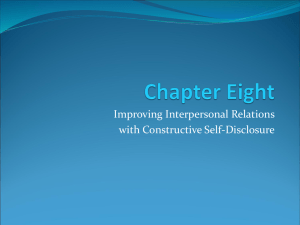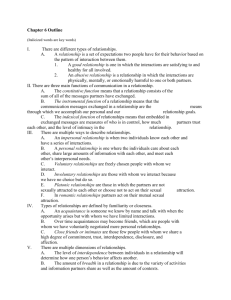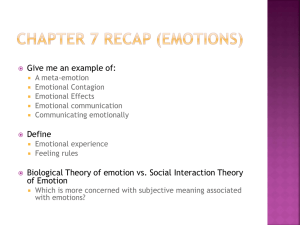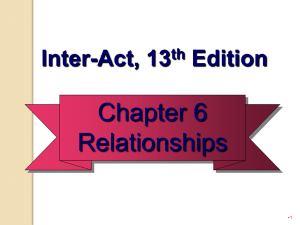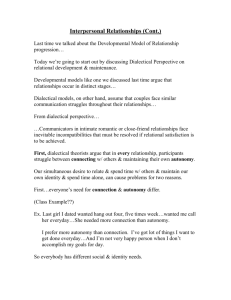Interpersonal Comm Theory - dwyersinterculturalcommunication
advertisement
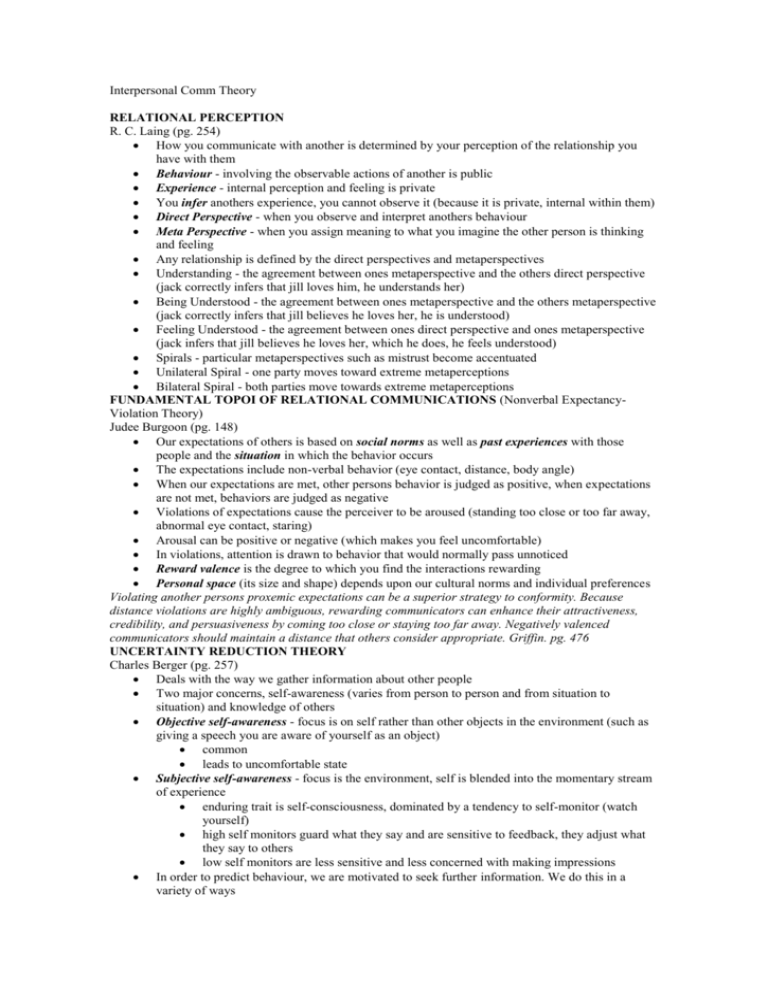
Interpersonal Comm Theory RELATIONAL PERCEPTION R. C. Laing (pg. 254) How you communicate with another is determined by your perception of the relationship you have with them Behaviour - involving the observable actions of another is public Experience - internal perception and feeling is private You infer anothers experience, you cannot observe it (because it is private, internal within them) Direct Perspective - when you observe and interpret anothers behaviour Meta Perspective - when you assign meaning to what you imagine the other person is thinking and feeling Any relationship is defined by the direct perspectives and metaperspectives Understanding - the agreement between ones metaperspective and the others direct perspective (jack correctly infers that jill loves him, he understands her) Being Understood - the agreement between ones metaperspective and the others metaperspective (jack correctly infers that jill believes he loves her, he is understood) Feeling Understood - the agreement between ones direct perspective and ones metaperspective (jack infers that jill believes he loves her, which he does, he feels understood) Spirals - particular metaperspectives such as mistrust become accentuated Unilateral Spiral - one party moves toward extreme metaperceptions Bilateral Spiral - both parties move towards extreme metaperceptions FUNDAMENTAL TOPOI OF RELATIONAL COMMUNICATIONS (Nonverbal ExpectancyViolation Theory) Judee Burgoon (pg. 148) Our expectations of others is based on social norms as well as past experiences with those people and the situation in which the behavior occurs The expectations include non-verbal behavior (eye contact, distance, body angle) When our expectations are met, other persons behavior is judged as positive, when expectations are not met, behaviors are judged as negative Violations of expectations cause the perceiver to be aroused (standing too close or too far away, abnormal eye contact, staring) Arousal can be positive or negative (which makes you feel uncomfortable) In violations, attention is drawn to behavior that would normally pass unnoticed Reward valence is the degree to which you find the interactions rewarding Personal space (its size and shape) depends upon our cultural norms and individual preferences Violating another persons proxemic expectations can be a superior strategy to conformity. Because distance violations are highly ambiguous, rewarding communicators can enhance their attractiveness, credibility, and persuasiveness by coming too close or staying too far away. Negatively valenced communicators should maintain a distance that others consider appropriate. Griffin. pg. 476 UNCERTAINTY REDUCTION THEORY Charles Berger (pg. 257) Deals with the way we gather information about other people Two major concerns, self-awareness (varies from person to person and from situation to situation) and knowledge of others Objective self-awareness - focus is on self rather than other objects in the environment (such as giving a speech you are aware of yourself as an object) common leads to uncomfortable state Subjective self-awareness - focus is the environment, self is blended into the momentary stream of experience enduring trait is self-consciousness, dominated by a tendency to self-monitor (watch yourself) high self monitors guard what they say and are sensitive to feedback, they adjust what they say to others low self monitors are less sensitive and less concerned with making impressions In order to predict behaviour, we are motivated to seek further information. We do this in a variety of ways Passive strategies - we observe reactivity search - observing the person actually doing something disinhibition search - observing a person in informal situations where they are less likely to self-monitor and behave naturally Active strategies - asking or manipulating the environment Interactive strategies - interrogation and self-disclosure (which creates a desire on the part of the other to self-disclose) Uncertainty reduction is culturally dependent High-context cultures rely heavily on the overall situation (such as Japanese) Low-context cultures rely more on explicit verbal content of messages (such as British) When strangers meet, their primary concern is to reduce uncertainty about the other person and their relationship. As verbal output, nonverbal warmth, self-disclosure, similarity, and shared communication networks increase, uncertainty goes down, and vice versa. Information seeking and reciprocity are positively correlated with uncertainty. Griffin, pg. 477 SELF DISCLOSURE Sidney Jourard (pg. 260) Honest communication relies upon openess or transparency Transparency - allowing the world to disclose itself freely, and disclosing oneself to others Personal growth (change) is a direct result of openess Self-disclosure increases with intimacy when rewarded with the need to reduce uncertainty when reciprocated with woman more than men (this might be cultural) Satisfaction in a relationship is highest when the level of self-disclosure is moderate Women self-disclose more with people they like, men with people they trust Wide differences in levels of self-disclosure between cultures SOCIAL PENETRATION THEORY Gerald Miller (pg. 264) Relationships become more intimate over time when disclosure takes place Tries to forecast the future of a relationship (is it worthwhile) on the basis of projected rewards and costs Self-disclosure occurs in stages, like peeling an onion Five stages of disclosure (Altman and Taylor) superficial, what kind of music you like political religious beliefs and attitudes deeply held fears and fantasies concept of self Outer stages occur more rapidly than inner stages, self-disclosure is reciprocal Social Penetration Theory. [Online]. Available http://chadwick.jlmc.iastate.edu/theory/spt.html Interpersonal closeness proceeds in a gradual and orderly fashion from superficial to intimate levels of exchange as a function of both immediate and future outcomes. Lasting intimacy requires continual mutual vulnerability through breadth and depth of self-disclosure. Griffin, pg. 477 RELATIONAL DISSOLUTION Leslie Baxter (pg. 266) The way couples use communication to end relationships Direct strategies - involve the explicit statement of desire to end the relationship, Indirect strategies do not Other strategies project concern for the other, or expediency (regardless of the consequences to the other persons feelings) Endings can be unilateral or bilateral Indirect strategies of unilateral disengagement - withdrawal (avoiding contact), pseudodeescalation (lets be friends), cost escalation (being more annoying) Indirect strategies for bilateral disengagement - fading away, mutual pseudodeescalation Direct unilateral disengagement - fait accompli (simple statement that it is over), state-of-therelationship talk (attempt to analyze the relationship) Direct bilateral disengagement - attributional conflict (a fight where each blames the other), negotiated farewell (mutual parting without hostility) Strategies for disengagement appear to be learnt, you have more as you get older Your personality is related to which strategy you will use, apprehensive people tend to choose indirect strategies Trajectory - the course taken during the breakup, depends upon situation and personal decisions Persevering indirectness trajectory - indirect methods of communicating over several occassions Ambivalent indirectness trajectory - unilateral and indirect, but at least one attempt was made to repair Swift explicit mutuality trajectory - termination was bilateral and direct, no attempt was made to repair Mutual ambivalence trajectory - indirect, several repair attempts, long time taken for breakup to finally occur DIALECTICAL THEORY OF FRIENDSHIPS William Rawlins (pg. 268) The challenges of friendships arise chiefly from the need to manage a variety of contradictions, or dialectics A dialectic is a tension between opposites in a system that demands resolution Two general classes of dialectics operate in friendships Contextual Dialectics - meaning of friendship within the broader culture contradictions between public and private governed by social and cultural expectations, creates tension, eg, cross-sex friendships ideal versus real - expectations versus what exists, friends are meant to be loyal, but at what cost? Interactional Dialectics - ambiguities of everyday communication in any friendship freedom to be independent and the freedom to be dependent - let people lead their own lives yet act as advisers affection and instrumentality - tension between valuing a friend as an end in itself versus using the friend as a means to some other end judgement and acceptance - accept us as we are, but called upon to make judgements and give advice expressiveness and protectiveness - open expression of feelings versus not wanting to hurt feelings THEORY OF MARRIAGE TYPES Mary Anne Fitzpatrick (pg. 271) Uses a questionnaire - the relational dimensions instrument, asks individuals about various aspects of their marriage Marriages can be categorized by how partners use their space, time and energy the extent to which they express their feelings exertion of power sharing of a common philosophy of marriage Questionnaire measures three factors Ideology - variable involving conventional vs nonconvential ideas of family Interdependence - variable reflecting dependence versus autonomy in a marriage Conflict - amount of disagreement or clash in a marriage Married couples cluster into three distinct groups Traditionals - conventionial views of marriage, place value on stability and certainty, strong independence and share much companionship Independents - do not rely upon each other much. They value their own autonomy and often have separate rooms. Often have friends outside the family, often vie for power, and are not shy refuting each others arguments Separates - ambivalent about their roles and relationship. Conflicts do not last long. Watchful attitude. Ask questions. Seldom seek advice. Not very expressive. Often partners do not have the same schema, they are mixed in type The schemas are used to guide your actions in relating and interacting with your spouse and serve to understand your entire family system ATTRIBUTION THEORY OF CONFLICT Alan Sillars (pg. 275) How you deal with a conflict depends upon how you place blame Three general strategies of conflict resolution are seen in interpersonal relationships Avoidance Behaviors - employ no or indirect communication denial and equivocation, direct or implicit denial topic management, changing the subject, final words noncommittal remarks, abstract remarks, unfocused questions, rephrasing the question irreverent remarks, joking Competitive Behaviors - involve negative communication confrontative remarks, personal criticism, rejection, hostile questioning, sarcasm, denial of responsibility Cooperative Behaviors - involve open and positive communication analytical remarks, describing the problem, disclosing and soliciting disclosure, soliciting criticism concillatory remarks, empathy or support, concessions, accepting responsibility Three ways in which attributions are important determinants of the definition and outcome of conflicts selection of strategy to deal with the conflict - cooperative strategy selected if you attribute cooperation to the other, if you thought you were to blame you might select a cooperative strategy biases in the attribution process discourage the use of integrative strategies - tendency to hold others accountable for negative events but not yourself strategy chosen affects the outcome of the conflict - cooperative strategies encourage integrative solutions and information exchange, but competitive strategies escalate and may lead to less outcome satisfaction Griffin. (1994). A first look at communication theory. (2nd Ed.). McGraw Hill.
